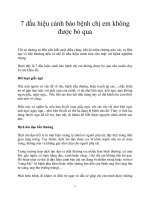Dấu hiệu cảnh báo: Các bảng điểm nhận biết sớm sepsis - Barbara McLean
Bạn đang xem bản rút gọn của tài liệu. Xem và tải ngay bản đầy đủ của tài liệu tại đây (2.28 MB, 30 trang )
<span class='text_page_counter'>(1)</span><div class='page_container' data-page=1>
<b>Heed the Warning:</b>
<b>Early Warning Scores for </b>
<b>Sepsis Identification</b>
Vietnam 2019: Sepsis
Barbara McLean,
MN, CCNS-BC, NP-BC, FCCMGrady Health Systems
</div>
<span class='text_page_counter'>(2)</span><div class='page_container' data-page=2>
OBJECTIVES
• To understand and be able to identify the
differences between Sepsis and Shock
• To appreciate the role of SIRS in identifying
patients at risk
• To understand the morbidity and mortality of Sepsis
in relation to length of stay, current guidelines, cost
to health care systems.
• To understand modalities of treatment which
</div>
<span class='text_page_counter'>(3)</span><div class='page_container' data-page=3></div>
<span class='text_page_counter'>(4)</span><div class='page_container' data-page=4>
. accessed August 7, 2015
</div>
<span class='text_page_counter'>(5)</span><div class='page_container' data-page=5></div>
<span class='text_page_counter'>(6)</span><div class='page_container' data-page=6>
<i><b>Sepsis 2016</b></i>
• <b>Infected: Use SIRS + suspicion</b>
• <b>Sepsis (with organ dysfunction)</b> – now defined as
life-threatening organ dysfunction caused by a
dysregulated host response to infection. <i><b>This is a </b></i>
<i><b>clinical diagnosis.</b></i>
o Identify with modified SIRS and Change in LOC
• <b>Septic Shock</b> – a subset of Sepsis with circulatory and
cellular/metabolic dysfunction associated with a higher
risk of mortality. <i><b>This is a clinical diagnosis.</b></i>
</div>
<span class='text_page_counter'>(7)</span><div class='page_container' data-page=7></div>
<span class='text_page_counter'>(8)</span><div class='page_container' data-page=8>
<i>JAMA</i>. 2016;315(8):762-774. doi:10.1001/jama.2016.0288
<b>Suggested Clinical Criteria for </b>
<b>Sepsis (if in ICU?) </b>
Infection + 2 or more SOFA points (above
baseline)
<b>Consider Sepsis outside ICU if</b>
</div>
<span class='text_page_counter'>(9)</span><div class='page_container' data-page=9>
QUICK SOFA / QSOFA
<b>> 22/ min</b> <b>SBP </b>
<b>≤100mmHg</b>
In patients with infection a qSOFA
score > 2 is associated with higher
mortality and prolonged ICU stay.
<i><b>SEPSIS Scoring Tool: Adding Organ Dysfunction</b></i>
</div>
<span class='text_page_counter'>(10)</span><div class='page_container' data-page=10>
MEWS Scoring Algorithm: Making it Simple
•
Uses vital signs to generate an acuity score
•
No process change or manual entry
</div>
<span class='text_page_counter'>(11)</span><div class='page_container' data-page=11></div>
<span class='text_page_counter'>(12)</span><div class='page_container' data-page=12>
5-6
7+
MEWS SCORING ALGORITHM: MAKING IT SIMPLE
1-4
</div>
<span class='text_page_counter'>(13)</span><div class='page_container' data-page=13></div>
<span class='text_page_counter'>(14)</span><div class='page_container' data-page=14>
<b>3 </b>
<b>hr</b> <b>6 h</b>
<b>r.</b>
S
t
EP-1: EARLY MANAGEMENT BUNDLE
<b>Measures & Intervention Required:</b>
Blood culture before
antibiotics
Antibiotics
Fluid resuscitation
Lactate level
Set Measure ID # SEP-1-8; Early Management Bundle, Severe Sepsis/Septic Shock
<b>Interventions Required:</b>
Lactate level repeated (If
elevated)
Vasopressors if necessary
Optimize fluid
Severe Sepsis
Time Zero
StEP-1 By <i><b>3</b></i> Hours
</div>
<span class='text_page_counter'>(15)</span><div class='page_container' data-page=15>
<i>BEFORE 3 HOURS ARE UP!</i>
<b>To Be Completed by 3 Hours</b> <b>Of Time Of Presentation:</b>
1. Obtain blood cultures prior to administration of
antibiotics.
2. Measure lactate level.
3. Administer broad spectrum antibiotics.
4. Administer 30ml/kg crystalloid for hypotension,
</div>
<span class='text_page_counter'>(16)</span><div class='page_container' data-page=16>
StEP-1 By <i><b>3</b></i> Hours
“Delays in administering all four
guidelines recommendations,
<i>even </i>
<i>when they did not exceed 3 hours</i>
,
were associated with a significant
increase in in-hospital mortality.”
</div>
<span class='text_page_counter'>(17)</span><div class='page_container' data-page=17>
<b>3 </b>
<b>hr</b>
SEP-1: EARLY MANAGEMENT BUNDLE
<b>Measures & Intervention Required:</b>
Blood culture before
antibiotics
Antibiotics
Fluid resuscitation
Lactate level
Grady RRT protocol
Severe Sepsis
Time Zero
<i><b>Our Clock Is One Hour!</b></i>
<b>1 h</b>
</div>
<span class='text_page_counter'>(18)</span><div class='page_container' data-page=18>
<b>Guidelines For Initial Resuscitation In Patients </b>
<b>With Sepsis Or Septic Shock</b>
. Rhodes A et al. Intensive Care Med. 2017;43:304-377.
<b>Initial resuscitation </b>
<b>guidelines</b>
• <b>At least 30 mL/kg of IV crystalloid fluid </b>
<b>recommended within the first 3 hours</b>
</div>
<span class='text_page_counter'>(19)</span><div class='page_container' data-page=19>
<b>Study</b> <b>Year</b> <b>Mortality Before (%)</b> <b>Mortality After (%)</b>
</div>
<span class='text_page_counter'>(20)</span><div class='page_container' data-page=20>
3 Recent Large Randomized Control Trials:
Although advanced severe sepsis therapies (such as central
line placement, SVO2 goals, etc) did not show improved
outcomes, <b>all were randomized after early recognition and </b>
<b>standard therapies including antibiotics and fluid </b>
</div>
<span class='text_page_counter'>(21)</span><div class='page_container' data-page=21>
Combo Therapy
•
Choose
o
Aminoglycosides or Aztreonam or
Ciprofloxacin
o
Cephalosporins,
(1st and 2nd Generation) <i>- or –</i>o
Clindamycin
<i>- or -</i>Daptomycin
- <i>or </i>-Glycopeptides
<i>- or -</i>Linezolid
<i>- or -</i>Macrolides
<i>- or –</i>
Penicillins
</div>
<span class='text_page_counter'>(22)</span><div class='page_container' data-page=22>
<b>3 </b>
<b>hr</b> <b>6 h</b>
<b>r.</b>
SEP-1: EARLY MANAGEMENT BUNDLE
<b>Measures & Intervention Required:</b>
Blood culture before
antibiotics
Antibiotics
Fluid resuscitation
Lactate level
Set Measure ID # SEP-1-8; Early Management Bundle, Severe Sepsis/Septic Shock
<b>Interventions Required:</b>
Lactate level repeated (If
elevated)
Vasopressors if necessary
Optimize fluid
Severe Sepsis
Time Zero
StEP-2 By <i><b>6</b></i> Hours
<b>1 h</b>
<b>r</b>
</div>
<span class='text_page_counter'>(23)</span><div class='page_container' data-page=23>
<b>3 </b>
<b>hr</b> <b>6 h</b>
<b>r.</b>
Severe
Sepsis
Time Zero
<b>Interventions Required:</b>
<b>ALL of Severe Sepsis +</b>
<b>Fluid 30 ml/kg</b>
<b>(NO exclusionary </b>
<b>criteria)</b>
<b>Physical Exam (ALL)</b>
• Vital Signs (T, HR, RR, BP)
• Cardiopulmonary exam
• Capillary refill evaluation
• Peripheral Pulse evaluation
• Skin evaluation
<b>Hemodynamics (2 of 4)</b>
• CVP
• SVO<sub>2</sub>
• Bedside cardiovascular ultrasound
• Passive leg raise / fluid challenge
Shock Assessment
<b>Interventions Required:</b>
<b>Persistent Hypotension</b>
Within 1 hour of fluid add
VASOPRESSOR
<b>Persistent Hypoperfusion</b>
<b>OR Lactate > 4</b>
Shock Assessment (1 of 2)
</div>
<span class='text_page_counter'>(24)</span><div class='page_container' data-page=24>
COMMON ISSUES IN SHOCK
• Inadequate oxygen delivery to meet metabolic
demands
• Results in global tissue hypoperfusion and
metabolic acidosis
• Most important, evidence of hypoperfusion: All
shocks
o hypotension
o Lactic acid
o Base deficit
o SvO2 or ScV02
o pH
Focus on tissue acidosis
and
</div>
<span class='text_page_counter'>(25)</span><div class='page_container' data-page=25>
COMPENSATORY RESPONSE IN SHOCK
• Inadequate systemic oxygen delivery
activates autonomic responses to maintain
systemic oxygen delivery
• Sympathetic nervous system
• NE, epinephrine, dopamine, and cortisol release
• Causes vasoconstriction, increase in HR, and increase of
cardiac contractility (cardiac output)
• Renin-angiotensin axis
• Water and sodium conservation and vasoconstriction
• Increase in blood volume and blood pressure
</div>
<span class='text_page_counter'>(26)</span><div class='page_container' data-page=26>
Acute kidney injury <sub>Myocardial injury</sub>
<b>LOW MAP IS ASSOCIATED WITH SERIOUS </b>
<b>ADVERSE EVENTS</b>
Risk of both kidney and cardiac injury increases with decreasing MAP
<i>Adapted from Walsh M et al. Anesthesiology. 2013;119:507-515.</i>
0.12
30 40 50 60 70 80
Lowest MAP (mm Hg)
P
rob
ab
ili
ty
o
f
ac
ut
e
k
idn
ey
inj
ury
0.04
0.06
0.08
0.10
0.08
30 40 50 60 70 80
Lowest MAP (mm Hg)
</div>
<span class='text_page_counter'>(27)</span><div class='page_container' data-page=27>
<b>DURATION OF LOW MAP AND ADVERSE EVENTS </b>
<i>Adapted from Walsh M et al. Anesthesiology. 2013;119:507-515.</i>
0 minutes 1 to 5 minutes 6 to 10 minutes 11 to 20 minutes >20 minutes
A
dj
usted
od
ds
ratio
1
1.5
2
2.5
Acute kidney injury Cardiac complication Myocardial injury
</div>
<span class='text_page_counter'>(28)</span><div class='page_container' data-page=28>
TAKE HOME POINTS
•
Suspect Sepsis Early
•
Quantify patients at risk with MEWS
•
Make it automatic
•
Re-Evaluate Patients Promptly
•
Treat as a team event and if determine
patient is septic treat as a “code sepsis”
•
Apply antibiotics as STAT drugs
•
Use your clinical judgment as you fluid
</div>
<span class='text_page_counter'>(29)</span><div class='page_container' data-page=29>
To Save Lives
...
<b>Early</b> fluid resuscitation
<b>Early</b> identification
</div>
<span class='text_page_counter'>(30)</span><div class='page_container' data-page=30>
And STOP SEPSIS!
Barbara McLean,
MN, CCNS-BC, NP-BC, FCCMGrady Health Systems
</div>
<!--links-->
<a href=' accessed August 7'>. accessed August 7</a>









